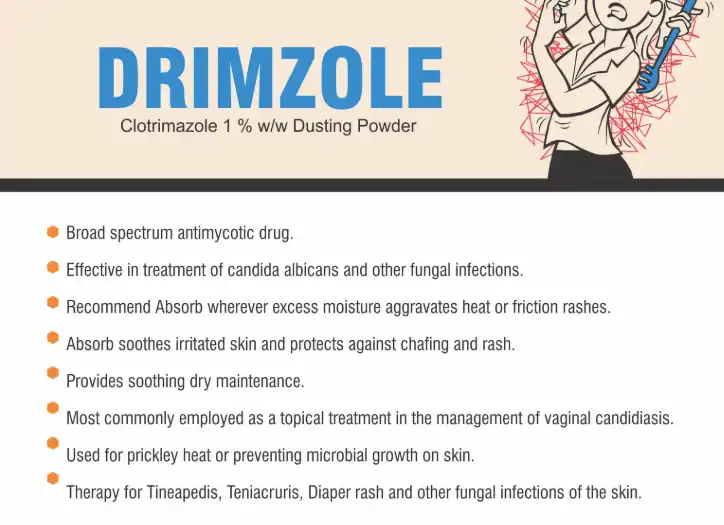Clotrimazole powder is a widely used antifungal medication that has gained popularity for its effectiveness in treating various fungal skin infections. As a topical treatment, it offers a convenient and accessible solution for many individuals suffering from common fungal ailments. In this blog post, we'll explore the efficacy of clotrimazole powder in treating fungal skin infections, its applications, and how it compares to other antifungal treatments.
How does Clotrimazole Powder work against fungal infections?
Clotrimazole powder is an antifungal medication that belongs to the azole class of drugs. Its mechanism of action is primarily focused on disrupting the fungal cell membrane, which is crucial for the survival and growth of fungal organisms. Here's a detailed look at how clotrimazole powder works to combat fungal infections:
- Inhibition of ergosterol synthesis: Clotrimazole works by inhibiting the synthesis of ergosterol, a vital component of fungal cell membranes. By interfering with this process, the drug compromises the integrity of the fungal cell membrane.
- Increased membrane permeability: As a result of the disrupted ergosterol synthesis, the fungal cell membrane becomes more permeable. This increased permeability allows essential components to leak out of the fungal cells, ultimately leading to cell death.
- Broad-spectrum activity: Clotrimazole is effective against a wide range of fungal species, including dermatophytes (responsible for conditions like athlete's foot and ringworm), yeasts (such as Candida species), and some molds.
- Local action: When applied topically as a powder, clotrimazole acts directly on the site of infection. This localized action helps to maximize its effectiveness while minimizing systemic absorption and potential side effects.
- Antifungal and anti-inflammatory properties: In addition to its primary antifungal action, clotrimazole has been shown to possess some anti-inflammatory properties. This dual action can help alleviate symptoms associated with fungal infections, such as itching and redness.

The effectiveness of clotrimazole powder in treating fungal infections is attributed to its ability to target the fungal organisms directly while being well-tolerated by human skin. Its mechanism of action makes it a potent tool in the fight against various fungal skin infections, providing relief and promoting healing for affected individuals.
What types of fungal infections can Clotrimazole Powder treat?
Clotrimazole powder is a versatile antifungal treatment that can effectively address a wide range of fungal skin infections. Its broad-spectrum activity makes it suitable for various conditions caused by different types of fungi. Here's an overview of the fungal infections that clotrimazole powder can treat:
- Athlete's foot (tinea pedis): This common fungal infection affects the feet, particularly between the toes. Clotrimazole powder is highly effective in treating athlete's foot, helping to alleviate symptoms such as itching, burning, and scaling.
- Jock itch (tinea cruris): A fungal infection that occurs in the groin area, jock itch can be effectively treated with clotrimazole powder. The powder form is particularly useful in keeping the affected area dry and reducing friction.
- Ringworm (tinea corporis): This fungal infection can occur on various parts of the body, causing circular, red, itchy patches. Clotrimazole powder can be applied to treat ringworm effectively.
- Candidiasis: Yeast infections caused by Candida species, such as diaper rash or thrush, can be treated with clotrimazole powder. Its antifungal properties help combat the overgrowth of yeast on the skin.
- Pityriasis versicolor: This common fungal infection causes discolored patches on the skin, often on the chest, back, or upper arms. Clotrimazole powder can be used to treat this condition effectively.
- Intertrigo: This inflammatory condition often occurs in skin folds and can be complicated by fungal infections. Clotrimazole powder can help treat the fungal component of intertrigo.
- Fungal nail infections (onychomycosis): While primarily used for skin infections, clotrimazole powder may also be used as an adjunct treatment for mild cases of fungal nail infections.
The effectiveness of clotrimazole powder in treating these fungal infections is due to its ability to target a wide range of fungal species. Its powder form offers several advantages in the treatment of these conditions:
- Absorbs moisture: The powder helps keep the affected area dry, creating an unfavorable environment for fungal growth.
- Reduces friction: In areas prone to friction, such as between toes or in skin folds, the powder can help reduce irritation and promote healing.
- Easy application: The powder form allows for easy and even application, especially in hard-to-reach areas.
- Long-lasting effect: The powder can provide prolonged contact with the affected area, enhancing its effectiveness.
When using clotrimazole powder for fungal infections, it's important to follow the recommended treatment duration, which typically ranges from 2 to 4 weeks, depending on the specific condition and severity. Consistent application and proper hygiene practices are crucial for achieving optimal results and preventing recurrence of the infection.
How does Clotrimazole Powder compare to other antifungal treatments?
When considering antifungal treatments, it's essential to understand how clotrimazole powder compares to other options available. This comparison can help individuals and healthcare providers make informed decisions about the most suitable treatment for specific fungal infections. Let's explore how clotrimazole powder stacks up against other antifungal treatments:
- Clotrimazole vs. Other Azole Antifungals:
- Miconazole: Both clotrimazole and miconazole are effective against a wide range of fungal infections. They have similar mechanisms of action and efficacy. The choice between the two often comes down to personal preference or specific formulations available.
- Ketoconazole: While also an azole antifungal, ketoconazole is sometimes considered more potent than clotrimazole. However, it may have a higher risk of side effects, especially when used systemically.
- Econazole: This antifungal is similar in efficacy to clotrimazole for most superficial fungal infections. The choice between the two may depend on availability and cost.
- Clotrimazole vs. Allylamine Antifungals:
- Terbinafine: This allylamine antifungal is particularly effective against dermatophyte infections like athlete's foot. Some studies suggest it may be more effective than azoles for certain conditions, but it may also be more expensive.
- Naftifine: Another allylamine antifungal, naftifine, is effective against various fungal infections. It may have a faster onset of action compared to azoles in some cases.
- Clotrimazole vs. Other Antifungal Classes:
- Ciclopirox: This hydroxypyridone antifungal has a broad spectrum of activity and may be effective against some fungi resistant to azoles. However, it's often more expensive than clotrimazole.
- Tolnaftate: Primarily used for athlete's foot, tolnaftate is effective against dermatophytes but has a narrower spectrum compared to clotrimazole.
- Formulation Advantages:
- Powder form: Clotrimazole powder offers unique advantages in terms of keeping the affected area dry and reducing friction, which can be particularly beneficial for certain types of fungal infections.
- Other formulations: Clotrimazole is also available in cream, lotion, and solution forms, allowing for versatility in treatment based on the location and nature of the infection.
- Effectiveness and Speed of Action:
- Clotrimazole generally shows good effectiveness against most common fungal skin infections.
- The onset of symptom relief is typically within a few days of starting treatment, with full resolution often occurring within 2-4 weeks of consistent use.
- Some studies suggest that allylamines like terbinafine may have a faster onset of action for certain infections, but overall cure rates are often comparable.
- Safety Profile:
- Clotrimazole powder is generally well-tolerated with minimal side effects when used topically.
- It has a long history of safe use and is available over-the-counter in many countries.
- Compared to oral antifungals, topical treatments like clotrimazole powder have a significantly lower risk of systemic side effects.
- Cost-Effectiveness:
- Clotrimazole powder is often more affordable than newer antifungal medications.
- Its availability as a generic medication contributes to its cost-effectiveness.
In conclusion, clotrimazole powder stands as an effective, well-tolerated, and cost-effective option for treating a wide range of fungal skin infections. While other antifungal treatments may offer specific advantages in certain situations, clotrimazole's broad-spectrum activity, ease of use, and favorable safety profile make it a go-to choice for many healthcare providers and patients. The choice of antifungal treatment should always be based on the specific infection, patient factors, and clinical judgment. For persistent or severe infections, it's important to consult a healthcare professional to determine the most appropriate treatment approach.
If you are also interested in this product and want to know more product details, or want to know about other related products, please feel free to contact sasha_slsbio@aliyun.com.
References
- Gupta AK, et al. (2017). Topical antifungal agents for the treatment of onychomycosis. Expert Opinion on Pharmacotherapy, 18(13), 1331-1341.
- Khanna D, Bharti S. (2014). Clotrimazole: A Review. International Journal of Research in Pharmaceutical and Biomedical Sciences, 5(1), 1-6.
- Rotta I, et al. (2013). Efficacy of topical antifungals in the treatment of dermatophytosis: a mixed-treatment comparison meta-analysis involving 14 treatments. JAMA Dermatology, 149(3), 341-349.
- Sahoo AK, Mahajan R. (2016). Management of tinea corporis, tinea cruris, and tinea pedis: A comprehensive review. Indian Dermatology Online Journal, 7(2), 77-86.
- Crowley PD, Gallagher HC. (2014). Clotrimazole as a pharmaceutical: past, present and future. Journal of Applied Microbiology, 117(3), 611-617.
- Gupta AK, et al. (2018). The use of azole therapy for tinea pedis. Skin Therapy Letter, 23(5), 5-8.
- Havlickova B, et al. (2008). Epidemiological trends in skin mycoses worldwide. Mycoses, 51 Suppl 4, 2-15.
- Crawford F, Hollis S. (2007). Topical treatments for fungal infections of the skin and nails of the foot. Cochrane Database of Systematic Reviews, (3), CD001434.
- Ely JW, et al. (2014). Diagnosis and management of tinea infections. American Family Physician, 90(10), 702-710.
- Schaller M, et al. (2013). Antimycotic efficacy of drugs with dual mechanisms of action: a systematic review. Journal of Antimicrobial Chemotherapy, 68(7), 1487-1495.

